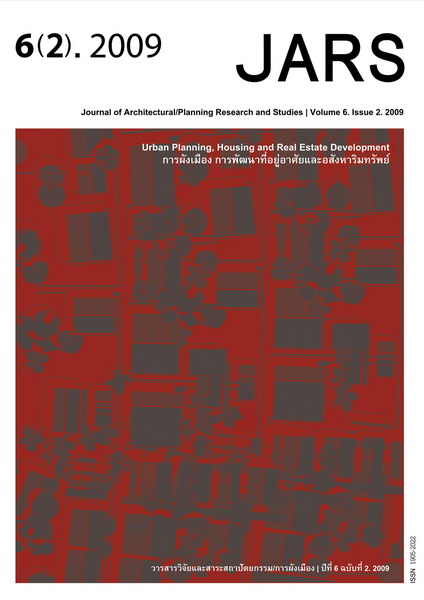Development of Downtown Open Space to Mitigate Urban Heat Island Effect: A Case Study of Silom Road, Bangkok
Main Article Content
Abstract
This research concerns the development of downtown open space to reduce the effect of urban heat
island (UHI) phenomenon. Research papers about open space development and UHI problem solution were
studied to be used as an analysis with a site survey. Due to the open space survey, the characteristics of the
open space that can reduce heat in downtown should be a useful open space that brings natural environment into downtown for pleasure and relaxation. Although this land usage cannot enhance economic benefits, it can provide social fields. Not only the characteristic of the natural environment, but also that of the physical component that the open space should take into account of consequently, the development of open space for the most
advantage, will turn to be public parks and vertical gardens.
Downloads
Article Details

This work is licensed under a Creative Commons Attribution-NonCommercial-NoDerivatives 4.0 International License.
All material is licensed under the terms of the Creative Commons Attribution 4.0 International (CC-BY-NC-ND 4.0) License, unless otherwise stated. As such, authors are free to share, copy, and redistribute the material in any medium or format. The authors must give appropriate credit, provide a link to the license, and indicate if changes were made. The authors may do so in any reasonable manner, but not in any way that suggests the licensor endorses you or your use. The authors may not use the material for commercial purposes. If the authors remix, transform, or build upon the material, they may not distribute the modified material, unless permission is obtained from JARS. Final, accepted versions of the paper may be posted on third party repositories, provided appropriate acknowledgement to the original source is clearly noted.
References
Chaichonitch, J. (1989). การศึกษาเอกลักษณ์ของการใช้ที่ดินย่านศูนย์กลางธุรกิจการค้าใจกลางกรุงเทพมหานคร:กรณีศึกษา เขตธุกิจสีลม-สุรสงศ์ และพื้นที่ที่เกี่ยวข้องเขตบางรัก [A study on the characteristic of central business land use in Bangkok Metropolitan area: A case study of Silom-Suriwong area, Bang Rak district]. Master Thesis, Faculty of Architecture, Chulalongkorn University, Bangkok, Thailand.
Chatdecha, S. (2000). การใช้ประโยชน์พื้นที่โล่งในย่านพาณิชยกรรมของกรุงเทพมหานคร: กรณีศึกษาบริเวณถนนสาทร - สีลม - สุรวงศ์ [The utilization of urban open space in commercial district of Bangkok: A case study of Satorn-Silom-Surawongse area]. Master Thesis, Faculty of Architecture, Chulalongkorn University, Bangkok, Thailand.
Devakul, J. (2007). แนวทางการออกแบบและพัฒนาสวนสาธารณะแบบยั่งยืนสำหรับพื้นที่ว่างเว้นจากการใช้งานในกรงเทพมหานคร ุ [Design guidelines for sustainable urban park in brownfield sites of Bangkok Metropolitan Area]. Journal of Architectural/Planning Research and Studies, 5(3), 123-138.
Science in Rural Schools (SiRS). (2004). พันธุ์พืช วัสดุชีวภาพเพื่อการปรับปรุงสภาพแวดล้อมในอาคาร [Plants: biological materials for environmental adjustment in buildings]. Retrieved November 11, 2007, from http://www.scithai.com/explore/content.asp?id=137&cat=23
Tienmanee, T. (2002). ปรากฏการณ์เกาะความร้อนกับสภาพทางกายภาพของเมือง [Urban heat island and urban physical environment]. Master Thesis, Faculty of Architecture, Silpakorn University, Bangkok, Thailand.


